
Tajikistan, officially the Republic of Tajikistan, is a landlocked country in Central Asia. Dushanbe is the capital and most populous city. Tajikistan is bordered by Afghanistan to the south, Uzbekistan to the west, Kyrgyzstan to the north, and China to the east. It is separated from Pakistan by Afghanistan's Wakhan Corridor.
The politics of Tajikistan nominally takes place in a framework of a presidential republic, whereby the President is both head of state and head of government, and of a multi-party system. Legislative power is vested in both the executive branch and the two chambers of parliament.
The spread of telecommunications services in Tajikistan – telephony, radio, television and internet – has not been as extensive as in many other countries.

Emomali Rahmon (; born Emomali Sharipovich Rahmonov, Tajik: Эмомалӣ Шарипович Раҳмонов, romanized: Emomalí Šarip Rahmon; ; October 5, 1952, is a Tajik politician who has been serving as The 3rd President of Tajikistan since 16 November 1994. Previously he was the Chairman of the Supreme Assembly of Tajikistan, as the de facto head of state from 20 November 1992 to 16 November 1994. Since 18 March 1998, he has also served as the leader of the People's Democratic Party of Tajikistan, which dominates the Parliament of Tajikistan. On 30 September 1999, he was elected vice-president of the UN General Assembly for a one-year term.
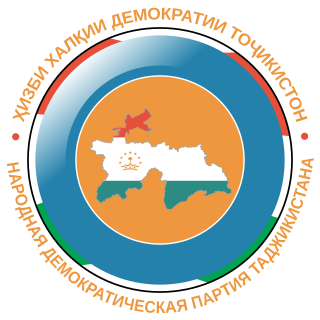
The People's Democratic Party of Tajikistan has been the dominant and ruling party of Tajikistan since 1994. Founded in 1994 by Abdulmajid Dostiev as the People's Party of Tajikistan, the seat of the party is located in the Palace of Unity in Dushanbe, the capital of Tajikistan. Since April 1998, the leader of the party has been the President of Tajikistan, Emomali Rahmon.
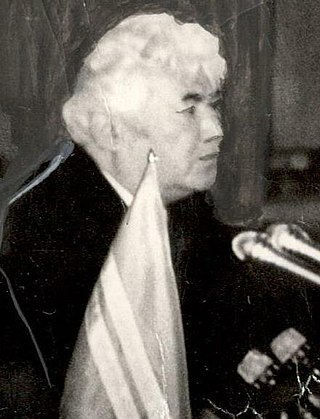
Rahmon Nabiyevich Nabiyev, also spelled Rakhmon Nabiev, was a Tajik politician who served as the First Secretary of the Communist Party of Tajikistan from 1982 to 1985 and twice as the 2nd President of Tajikistan from 23 September 1991 to 6 October 1991 and from 2 December 1991 to 7 September 1992. He was also partly responsible for the Tajik Civil War. Rising out of the regional nomenklatura, Nabiyev ascended to power in 1982 as First Secretary of the Communist Party of Tajikistan. In 1985, he was ousted in a corruption scandal.

The Tajikistani Civil War, also known as the Tajik Civil War, began in May 1992 and ended in June 1997. Regional groups from the Garm and Gorno-Badakhshan regions of Tajikistan rose up against the newly-formed government of President Rahmon Nabiyev, which was dominated by people from the Khujand and Kulob regions. The rebel groups were led by a combination of liberal democratic reformers and Islamists, who would later organize under the banner of the United Tajik Opposition. The government was supported by Russian military and border guards.

The Communist Party of Tajikistan is a communist party in Tajikistan, and the oldest political party in the country. The party was founded on 6 January 1924 and was the ruling party of the Tajik Autonomous Soviet Socialist Republic from 1924 to 1929 and the Tajik Soviet Socialist Republic from 1929 to 1990 as part of the Soviet Union as a republican branch of the Communist Party of the Soviet Union. It was banned in 1991 following the 1991 coup.
Colonel Mahmud Khudoiberdiyev was a rebel leader in Tajikistan who, while initially an ally of Tajik President Emomali Rahmon, became an opposition figure later on in his life. He is a former member of the Central Committee of the Tajik Communist Party and a former major in the Soviet Army. He also served as commander of the Tajik Army's First Brigade.

The following outline is provided as an overview of and topical guide to Tajikistan:
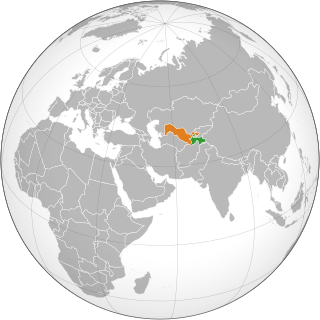
Tajikistan–Uzbekistan relations refers to the relations between the Republic of Tajikistan and the Republic of Uzbekistan.

Tajik National University is the first and largest university in Tajikistan. It enrolls 23,000 students per year in 18 different academic disciplines.
Televizioni Tojikiston, formerly known as Shabakai Yakum, is the national broadcaster of the Central Asian state of Tajikistan, headquartered in the capital city, Dushanbe. It began broadcasting on October 3, 1959.
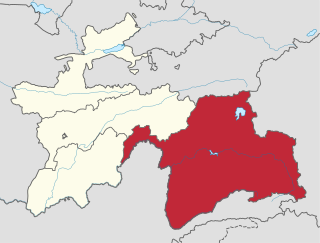
The Gorno-Badakhshan clashes consisted of fighting between Tajik government forces and an armed group led by Tolib Ayyombekov in Tajikistan's semi-autonomous Gorno-Badakhshan province in late July 2012. The Western media described the fighting as the worst in Tajikistan since 2010 or the 1992–1997 civil war.

A constitutional referendum was held in Tajikistan on 22 May 2016. A total of 41 constitutional amendments were proposed. The changes included:
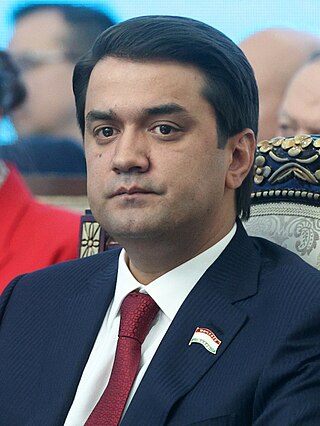
Rustam Emomali is a Tajik politician who is the current Chairman of the National Assembly of Tajikistan, Mayor of Dushanbe and the eldest son of Emomali Rahmon, the long-standing authoritarian leader of Tajikistan. Emomali's father appointed Emomali as the mayor of Dushanbe when he was 29 years old.

Ozoda Emomalievna Rahmonova is a Tajikistani politician who is the daughter of Emomali Rahmon, the long-standing authoritarian leader of Tajikistan.
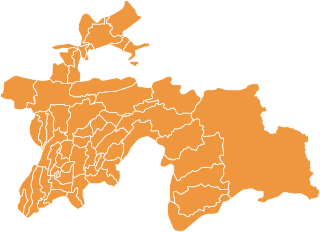
Presidential elections were held in Tajikistan on 11 October 2020. The result was a fifth straight victory for authoritarian long-term incumbent Emomali Rahmon of the People's Democratic Party, who was re-elected with over 90% of the vote. Rahmon was inaugurated for his fifth term on 30 October. He was sworn in at a ceremony at the Kokhi Somon Palace in Dushanbe.
The COVID-19 pandemic in Tajikistan is part of the worldwide pandemic of coronavirus disease 2019 caused by severe acute respiratory syndrome coronavirus 2. The virus was confirmed to have spread to Tajikistan when its index cases, in Dushanbe and Khujand, were confirmed on 30 April 2020.












